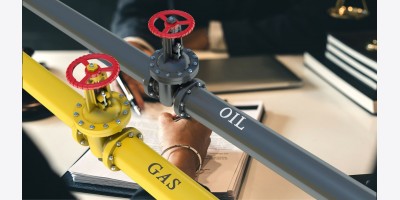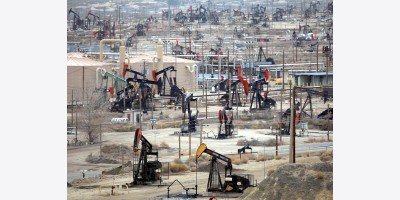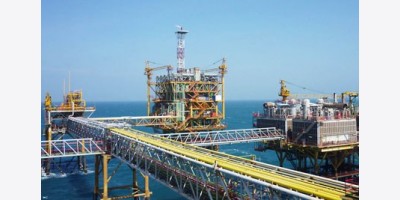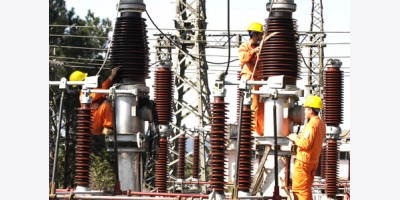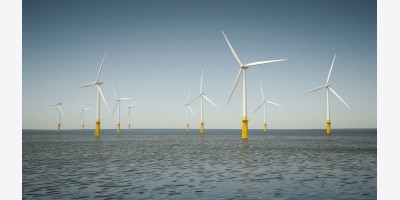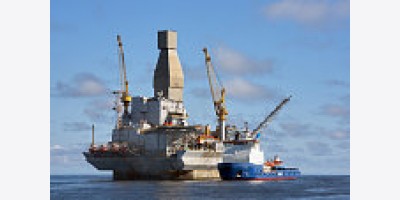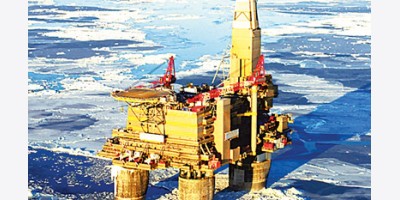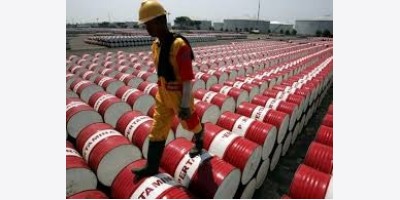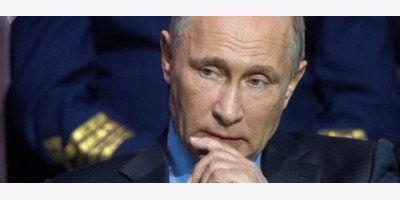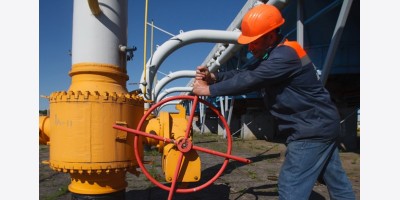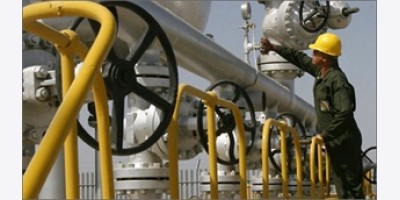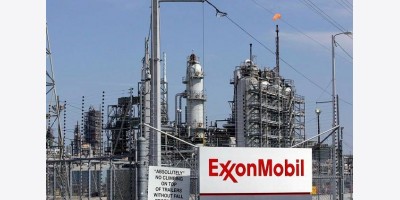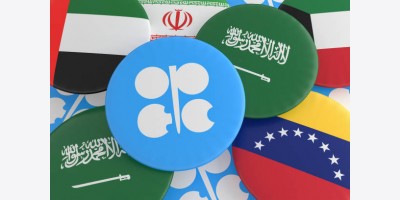PNG gas project makes first shipment to Japan
Business May. 27, 2014 - 06:40AM JST ( 1 )
PNG gas project makes first shipment to Japan File picture of a liquefied natural gas tanker in Western Australia, July 18, 2012 AFP
The first shipment of liquefied natural gas from a landmark $19 billion project in Papua New Guinea has left for Japan, U.S. oil giant ExxonMobil said Monday.
The project is the largest development ever undertaken in the Pacific country and ExxonMobil managing director Peter Graham called the shipment, which comes four years after construction began, “an historic moment”.
“This is the country’s largest resource project and it has taken the effort of many thousands of people to bring it to fruition,” he said.
“Revenue from the PNG LNG Project will support Papua New Guinea’s continued economic and social development.
“The PNG LNG Project demonstrates to the world what Papua New Guinea is capable of delivering.”
The project will supply four major customers in Taiwan, Japan and China and is expected to produce an expected nine trillion cubic feet (255 billion cubic meters) of LNG over its 30-year life.
At its peak, more than 21,000 people were employed during construction with the operators having to overcome flooding and extremely steep slopes as they built infrastructure including airfields and roads from scratch.
“Not only will the people of Papua New Guinea now benefit; their children and grandchildren will continue to enjoy the benefits and positive effects from this valuable resource development for many years to come,” PNG Prime Minister Peter O’Neill said.
However, critics say the project is environmentally devastating and has inflicted human rights abuses on villagers affected.
They also query whether the PNG government, which ranks poorly in international corruption rankings, will spend the revenues wisely.
The project includes gas production and processing facilities in PNG’s Southern Highlands and Western Provinces, liquefaction and storage facilities on the Gulf of Papua and more than 700 kilometers of pipelines.
ExxonMobil has the largest stake at 33.2%. Its partners include Oil Search Ltd (29%), the PNG government (16.6%), Australian energy firm Santos (13.5%), Japan’s Nippon Oil Corp (4.7%) and local landowners (2.8%).
© 2014 AFP
Asia, Europe account for 45% of Nigeria’s crude export
BY MICHAEL EBOH
Following a steep decline in United States’ demand for Nigeria’s crude, India, Netherlands and Spain have emerged as the highest buyers of the nation’s crude oil, accounting for 45.01 per cent of its total crude export in January.
CRUDE-OILSpecifically, data obtained from the Nigerian National Petroleum Corporation, NNPC, revealed that India was the highest recipient of Nigeria’s crude oil in January, accounting for 18.09 per cent of total crude export with 11.811 million barrels of crude oil.
The Netherlands followed with the purchase of 8.889 million barrels of crude, while Spain received 8.695 million barrels.
In general, Nigeria’s total crude export appreciated slightly by 1.19 per cent to 65.305 million barrels in the month under review, up from 64.537 million barrels in December 2013.
Crude Export
Europe was the major importer of majority of Nigeria’s crude during the review period with 34.377 barrels of crude, representing 52.64 per cent of its total crude export.
Asia and the Far East followed with the purchase of 15.67 million barrels, representing 23.99 per cent of the total crude export.
Nigeria’s crude export to other African countries stood at 6.509 million barrels, while South America purchased 5.903 million barrels of crude.
Further analysis of Nigeria’s crude oil export by destination revealed that France trailed India, Netherlands and Spain, receiving 6.561 million barrels of oil, while Brazil received 5.903 million barrels.
Others are Italy — 5.06 million barrels; South Africa — 2.9 million barrels; China —1.956 million barrels; Sweden — 1.948 million barrels and United States of America — 1.871 million barrels.
Impact of shale
In December 2013, the negative effect of shale exploration in the United States of America, USA, and other parts of the world, was brought to the fore, as Nigeria’s crude oil export to North America dropped by 91.31 per cent in one year.
Specifically, the NNPC disclosed that Nigeria exported 1.438 million barrels of crude oil to North America in December, down by 15.111 million barrels in December 2012.
North America accounted for 22.19 per cent of Nigeria’s total crude export by December 2012, but it dropped to 2.23 per cent by December 2013.
Prior to the decline, the US was the highest buyer of Nigeria’s crude, purchasing 14.279 million barrels in December 2012, thereby, accounting for 19.15 per cent of its total crude export and 86.28 per cent of total crude export to North America.
But by 2013 end, the US dropped to the 10th highest importer of Nigeria’s crude, with 1.438 million barrels.
The NNPC report also indicated that by December 2013, Europe was the highest importer of Nigeria’s crude, accounting for 47 per cent of Nigeria’s total export; followed by Asia and Far East, accounting for 26 per cent; while Africa accounted for 12 per cent of the total crude export.
South America accounted for 10 per cent while the Oceania/Pacific and North America accounted for three per cent and two per cent respectively.
India emerged the highest importer of Nigeria’s crude in December 2013, with 13.086 million barrels, followed by the Netherlands with 9.866 million barrels, and France 4.497 million barrels.
Chinese Premier to Sign Trade Agreements in Oil Supplier Angola
bloomberg.com
Chinese Premier Li Keqiang arrived for a two-day visit to Angola, China’s second-largest oil supplier, where he’s expected to approve funding agreements and hold talks with President Jose Eduardo Dos Santos.
It’s the first trip to the southwest African country by a Chinese premier in eight years and deals to finance hydropower and agriculture will be signed, state-run China Daily.com reported today. Several government lenders are considering investing amounts in the billions of dollars in the country, according to an administrator at China Railway Airport Construction Group Co. in Luanda, Angola’s capital, who declined to be identified in line with company policy.
Angola is Africa’s second-biggest crude producer, pumping about 1.54 million barrels a day last month, and sells about half its output China. The Asian nation was among the first to finance Angola’s rebuilding after a 27-year civil war ended in 2002, offering oil-backed loans to fund construction projects as European and other donors imposed conditions such as improving democracy and transparency.
“The trouble for China is that its oil-for-infrastructure model is not sustainable long-term in Angola,” Alex Vines, head of the Africa Program at Chatham House in London, said in a May 6 report. “If Beijing is to continue to lock in oil supplies, a new type of partnership not reliant on Chinese construction contractors will need to be established.”
Angola’s crude shipments to China rose 9.9 percent to 10.7 million metric tons in the first quarter, second only to Saudi Arabia, Vines said. There are more than 258,000 Chinese working in Angola and Li will meet with company leaders as concerns mount about the host country’s unemployment, estimated at about 25 percent by the African Development Bank.
Housing Project
Li is expected to tour Kilamba, one of several residential complexes built by Chinese companies such as Beijing-based Citic Construction Co. to accommodate tens of thousands of people around the capital, which has a population of about 6 million. Kilamba’s 900-hectare first phase cost $3.54 billion to build 115 apartment blocks. Li is scheduled to meet his Angolan counterpart tomorrow afternoon.
China-Angola trade reached $36 billion last year, according to China Daily.com. Accumulated investment by China in Angola has exceeded $8 billion, it said. China Railway Airport Construction is building a new international airport in Luanda and spent about $1.8 billion refurbishing the Benguela Railway linking the Democratic Republic of Congo to the Atlantic Ocean.
Africa Trip
Li and his 129-member delegation are on the third stop of a four-nation African tour following Ethiopia and Nigeria before heading to Kenya. Angola, a communist country from its 1975 independence from Portugal until after the Berlin Wall fell, has been run by dos Santos since 1979. He’s the longest-serving ruler in Africa after Equatorial Guinea President Teodoro Obiang Nguema Mbasogo.
“This visit emphasizes that China continues to invest in Africa, is a long-term predictable partner and offers ‘win-win’ partnerships for African governments without conditionality,” Vines said. “The visit to Luanda from 8 May is the most important on this trip for Premier Li.”
To contact the reporters on this story: Colin McClelland in Luanda at cmcclelland1@bloomberg.net; Manuel Soque in Luanda at msoque@bloomberg.net
To contact the editors responsible for this story: Antony Sguazzin at asguazzin@bloomberg.net Paul Richardson, Ben Holland
©2014 Bloomberg L.P. ALL RIGHTS
By Jose Orozco and Pietro D. Pitts May 26, 2014 11:09 PM GMT+0700
Petroleos de Venezuela SA will receive a $2 billion pre-payment for oil and fuel supplied to OAO Rosneft (ROSN) as South America’s biggest crude exporter seeks funds amid domestic shortages and the world’s fastest inflation.
Rosneft, Russia’s largest oil producer, will make the payment to Venezuela’s state oil producer PDVSA in exchange for more than 1.6 million tons of oil and 7.5 million tons of oil products during a five-year period, Rosneft said in a statement posted on its website May 24. On March 7, Venezuela signed a memorandum of understanding with Rosneft for $2 billion in financing for oil projects in Venezuela.
“This agreement represents a new phase of partnership between Rosneft and PDVSA,” Rosneft Chief Executive Officer Igor Sechin said in the statement. “Following the partnership in the upstream sphere, our companies start to cooperate in the sphere of trading.”
For Venezuela, the arrangement may help combat shortages of everything from car parts to pregnancy tests in a country with strict currency controls, 59 percent inflation and the world’s biggest oil reserves. Russia may be looking to strengthen ties with countries outside of the U.S.’s influence after President Vladimir Putin’s incursion into the Crimea region, Roger Tissot, a consultant with Tissot Associates, said.
“The deal could have materialized for two reasons: first, Russia desperately needs to gain friends and secondly Venezuela needs the money more than ever,” Tissot said by telephone from Vancouver.
Payments Due
Rosneft, the largest publicly traded oil company by output and reserves, has five joint ventures in Venezuela with PDVSA.
The Caracas-based company faces $4.3 billion in bond payments this year, while the government is scheduled to pay $3.3 billion, according to data compiled by Bloomberg.
Venezuela’s state energy company will sell as much as $5 billion of dollar bonds due in 2024 to state banks, with an interest rate of 6 percent, it said May 14. Banks probably will sell the notes to importers, who will raise dollars by selling them to overseas investors, according to Tamara Herrera, chief economist at financial research firm Sintesis Financiera.
Controls imposed under late-President Hugo Chavez have left importers unable to access foreign currency, with the resulting shortages spurring three months of protests against President Nicolas Maduro’s government that left 42 people dead.
Venezuela may have foreign-currency arrears to importers of as much as $13 billion, up from $9 billion at the end of 2013, Morgan Stanley said in a note on May 9.
The country allowed the bolivar to plunge 88 percent in March in a new market known as Sicad II. State banks are allowed to sell dollar-denominated bonds under the system to companies and individuals, who can then obtain hard currency by turning to the secondary bond market.
To contact the reporters on this story: Jose Orozco in Caracas at jorozco8@bloomberg.net; Pietro D. Pitts in Caracas at ppitts2@bloomberg.net
To contact the editors responsible for this story: Andre Soliani at asoliani@bloomberg.net James Attwood, Robin Saponar
By Jake Rudnitsky, Daryna Krasnolutska and Daria Marchak May 27, 2014 6:46 AM GMT+0700
President-elect Petro Poroshenko set Ukraine on a collision course with Russia even before the last vote had been counted, vowing to step up operations to rein in separatists in the east of the country.
“There will be a sharp increase in the efficiency of anti-terrorist operations,” Poroshenko said in Kiev yesterday. “They won’t last two or three months; they’ll last a few hours.” In Moscow, Foreign Minister Sergei Lavrov said that any escalation would be a “colossal mistake.”
The difficulty of Poroshenko’s task was clear in Donetsk, where paratroopers, helicopters and warplanes were deployed after rebels ignored an ultimatum to leave the local airport. A clash between government forces and gunmen near the city’s railway station left one dead, Novosti Donbassa reported.
Poroshenko is faced with a shrinking economy and a pro-Russian separatist movement that’s captured large swathes of the Donetsk and Luhansk regions, threatening to rip the former Soviet republic apart. Russia annexed the Black Sea Crimean peninsula in March.
Secretary of State John Kerry said in a statement that the U.S. “respects Ukraine’s sovereignty and territorial integrity, condemns and rejects Russia’s occupation and attempted annexation of Crimea, and remains committed to working with Ukraine and other partners to find a peaceful resolution to the conflict.”
Photographer: AFP/Sergei Gapon/Getty Images
While most in Ukraine’s easternmost regions didn’t vote, Poroshenko’s success was... Read More
Fighter Aircraft
Yet in Donetsk, the election brought no lull in the violence. As evening fell, fighter aircraft were again seen in the skies and explosions were heard in the city, with renewed fighting near the railway station, the Ostrov news website reported. The Novosti Donbassa news agency reported that a column of about 40 trucks carrying armed men was seen in Russia approaching the border with the Donetsk region. Fighting was also reported in Slovyansk and Mariupol.
In his first comments after the vote, Poroshenko said May 25 he’d seek to end the “war, chaos and disorder” by visiting the troubled eastern regions and working with Russia. Ukraine’s Central Election Commission declared him the winner with 54.4 percent of the vote, after 94 percent of ballots had been counted, Novosti Donbassa said.
Lavrov said the fact the vote was held is positive and reiterated President Vladimir Putin’s earlier pledge to respect the election’s outcome. There’s now an opportunity to establish a “mutually respectful, equal dialog,” he said.
While Poroshenko and Lavrov rattled sabers, Ukraine and Russia took a step toward rapprochement on the divisive issue of natural-gas payments during talks in Berlin.
Gas Payments
NAK Naftogaz Ukrainy is prepared to pay $2 billion to OAO Gazprom by May 29 to cover arrears, said EU Energy Commissioner Guenther Oettinger. A $500 million payment would follow by June 7 if the countries’ governments approve.
Energy Minister Yuri Prodan said the Ukrainian government would respond by Wednesday evening. Ukraine depends on Russia for about half its gas, and Europe gets about 15 percent of its supplies of the fuel through Soviet-era pipelines that cross Ukraine.
“We are ready to continue talks on gas price settlement of future gas supplies to Ukraine if we get payments this week, until Friday,” Russian Energy Minister Alexander Novak told a press conference.
Parliamentary Elections
Poroshenko said he’d call early parliamentary elections in 2014 as the nation seeks to draw a line under the rule of ousted President Viktor Yanukovych, the Russian-backed leader who fled for Moscow in February after deadly street protests backing closer European ties.
With a fortune of $1 billion according to the Bloomberg Billionaires Index, Poroshenko has flaunted his business acumen and promised to boost wages by nurturing employment and gearing the economy toward Europe through a trade pact. He reiterated yesterday that he’d sell his assets that include the Roshen chocolate company and will hire a bank to help.
The tycoon, who speaks Ukrainian and Russian fluently, is known for his ability to work with different camps. He was foreign minister under President Viktor Yushchenko, the hero of the 2004 Orange Revolution that helped overturn Yanukovych’s election win, before serving as economy minister under Yanukovych, who had returned to power in 2010.
To contact the reporters on this story: Daryna Krasnolutska in Kiev at dkrasnolutsk@bloomberg.net; Daria Marchak in Kiev at dmarchak@bloomberg.net; Volodymyr Verbyany in Kiev at vverbyany1@bloomberg.net
To contact the editors responsible for this story: Balazs Penz at bpenz@bloomberg.net Andrew Langley, Patrick Henry
By Asjylyn Loder May 27, 2014 6:00 AM GMT+0700
The U.S. shale patch is facing a shakeout as drillers struggle to keep pace with the relentless spending needed to get oil and gas out of the ground.
Shale debt has almost doubled over the last four years while revenue has gained just 5.6 percent, according to a Bloomberg News analysis of 61 shale drillers. A dozen of those wildcatters are spending at least 10 percent of their sales on interest compared with Exxon Mobil Corp.’s 0.1 percent.
“The list of companies that are financially stressed is considerable,” said Benjamin Dell, managing partner of Kimmeridge Energy, a New York-based alternative asset manager focused on energy. “Not everyone is going to survive. We’ve seen it before.”
Some investors are already bailing out. On May 23, Loews Corp. (L), the holding company run by New York’s Tisch family, said it is weighing the sale of HighMount Exploration & Production LLC, its oil and natural gas subsidiary, at a loss.
HighMount lost $20 million in the first three months of the year, after being unprofitable in 2013 and 2012, Loews said it its financial reports. As with much of the industry, HighMount has shifted its focus to oil after natural gas prices plunged and has struggled to find sites worth developing, company records show.
Mary Skafidas, a spokeswoman for Loews, declined comment.
In a measure of the shale industry’s financial burden, debt hit $163.6 billion in the first quarter, according to company records compiled by Bloomberg on 61 exploration and production companies that target oil and natural gas trapped in deep underground layers of rock. And companies including Forest Oil Corp. (FST), Goodrich Petroleum Corp. (GDP) and Quicksilver Resources Inc. (KWK) racked up interest expense of more than 20 percent.
Production Declines
Quicksilver acknowledges the company is over-leveraged, said David Erdman, a spokesman for Quicksilver. The company’s interest expense equaled almost 45 percent of revenue in the first quarter. “We have taken concrete measures to reduce debt,” he said.
Drillers are caught in a bind. They must keep borrowing to pay for exploration needed to offset the steep production declines typical of shale wells. At the same time, investors have been pushing companies to cut back. Spending tumbled at 26 of the 61 firms examined. For companies that can’t afford to keep drilling, less oil coming out means less money coming in, accelerating the financial tailspin.
Interest Expenses
“Interest expenses are rising,” said Virendra Chauhan, an oil analyst with Energy Aspects in London. “The risk for shale producers is that because of the production decline rates, you constantly have elevated capital expenditures.”
Chauhan wrote a report last year titled “The Other Tale of Shale” that showed interest expenses are gobbling up a growing share of revenue at 35 companies he studied. Interest expense for the 61 companies examined by Bloomerg totalled almost $2 billion in the first quarter, 4.1 percent of revenue, up from 2.3 percent four years ago.
The drilling spree boosted U.S. oil production to 8.4 million barrels a day, 16 percent more than a year ago and the highest since 1986. Growth has been driven by advances in horizontal drilling and hydraulic fracturing, or fracking, which unlocked crude and natural gas trapped in formations like North Dakota’s Bakken shale or the Marcellus in the U.S. northeast.
Costly Gains
The gains haven’t come cheaply. Goodrich said earlier this month that it’s trying to whittle its well costs in the Tuscaloosa Marine Shale down to $11.5 million apiece. The $1.1 billion company, based in Houston, spent almost $52 million more than it earned in the first quarter.
The company has enough money to cover its 2014 capital needs and is working with its board to fund 2015 as it ramps up drilling, spokesman Daniel Jenkins said in an e-mail.
A successful well announced last month has propelled Goodrich shares to $25.34, more than double the 2014 low of $12.28.
While borrowing to spend is typical of start-up companies, it’s not always sustainable. Forest Oil, where interest expense totaled 27 percent of revenue in the first quarter, in February reported disappointing well results, and warned that it might run afoul of its debt agreements. Forest on May 6 announced a plan to sell itself to Sabine Oil & Gas LLC in an all-stock transaction. Denver-based Forest declined to put a value on the deal. The company declined comment. Shares have declined 39 percent so far this year.
Eagle Ford
Zaza Energy Corp. (ZAZA), which got its start as a joint venture with Hess Corp. (HES), bought up oil rights in the Eagle Ford shale field and the nearby Eaglebine in South Texas, near the heart of the U.S. oil boom. Its first quarter revenue fell short of interest expense. The firm’s accountants in March voiced “substantial doubt” about the Houston-based company’s ability to stay afloat.
Hess, which dissolved the partnership almost two years ago, lost money on the deal. And its foray into what has turned out to be the biggest shale play in the U.S. prompted Elliott Management Corp., billionaire Paul Singer’s investment firm, to oust John Hess last year from the chairmanship of a company his father founded more than 80 years ago. Zaza has since entered into a joint venture with EOG Resources Inc. in Houston, one of the few shale companies to bring in more cash than it spends. Zaza’s shares have declined 28 percent this year.
“We are now significantly increasing our production volumes and revenue,” said Todd A. Brooks, president and chief executive officer.
Negative Outlook
Swift Energy Co. (SFY) has slowed drilling while trying to sell acreage or find a partner to shoulder some of the costs. The company on May 6 announced a $175 million joint venture with a unit of a government-controlled energy company in Indonesia. The proceeds will be used to help pay down debt. The deal announcement still didn’t stop Standard & Poor’s from cutting Swift’s credit rating on May 15 and tagging the company with a negative outlook. Shares have declined 19 percent so far this year.
“Traditionally we’ve been a financially conservative company,” said Bruce Vincent, president of Houston-based Swift. “We’ve become more leveraged than we historically have been and we’ve become uncomfortable with that.”
To contact the reporter on this story: Asjylyn Loder in New York at aloder@bloomberg.net
To contact the editors responsible for this story: Rick Schine at eschine@bloomberg.net Susan Warren
By Mikael Holter and Manus Cranny May 26, 2014 4:09 PM GMT+0700
Statoil ASA (STL), the biggest seller of gas to Europe after Russia’s OAO Gazprom, said the continent’s stability in fuel supplies has improved in the last decade, even as tensions over Ukraine have raised concerns over disruptions.
“From an energy-security perspective, the situation is actually better than it used to be in the last decade,” Statoil’s Chief Financial Officer Torgrim Reitan said in an interview with Bloomberg TV today. “The European market has developed significantly over the last decade. It’s now a liquid market, with multiple sources.”
Russia, which supplies about 30 percent of the European Union’s gas consumption, has threatened to cut off supplies to Ukraine unless the east-European country, ridden by a conflict between the central government and pro-Russian separatists, starts to prepay gas shipments after accumulating $3.5 billion in unpaid bills. More than half of Europe’s Russian gas is shipped through Soviet-era pipelines through Ukraine.
Tensions over Ukraine eased before yesterday’s presidential election in the country, as Russia’s President Vladimir Putin said he will work with the winner of the vote.
“Energy has always been geopolitical and it will remain so,” Reitan said. “But I also think it’s fair to say that the Russian supplies have remained stable and predictable for decades.”
Gazprom’s recent $400 billion deal to supply gas to China for 30 years “just demonstrates the importance” of that fuel and will come from reserves that aren’t meant for the European market, Reitan said.
Statoil will continue to supply Europe with a “significant” part of its gas needs from Norway, while the continent can also count on gas from Russia, North Africa and shipments of liquefied natural gas, he said.
To contact the reporters on this story: Mikael Holter in Oslo at mholter2@bloomberg.net; Manus Cranny in London at mcranny@bloomberg.net
To contact the editors responsible for this story: Will Kennedy at wkennedy3@bloomberg.net Jonas Bergman, Alastair Reed
By Eliot Caroom May 24, 2014 4:03 AM GMT+0700
Gasoline climbed to a three-week high as U.S. drivers were forecast to drive the most in nine years over Memorial Day weekend.
Futures rose 0.6 percent. AAA estimates that 31.8 million people will travel 50 miles or more by car this weekend, up from 31.4 million a year ago and the most since 2005. Memorial Day, which falls this year on May 26, marks the start of the summer driving season. Gasoline supplies were 213.4 million barrels in the week ended May 19, according to the Energy Information Administration, down from 220.7 million a year earlier.
“Gasoline is leading the way as we go into the holiday weekend with a gasoline demand forecast to be at the highest level in a number of years at the same time that inventories are about 3 percent lower than this time last year,” said Andy Lipow, president of Lipow Oil Associates LLC in Houston.
June-delivery gasoline rose 1.77 cents to $3.0235 a gallon on the New York Mercantile Exchange, the highest settlement since April 29. Prices gained 1.7 percent this week.
“We’re seeing an increase in travel this year primarily due to an improved economy,” Michael Green, a spokesman for AAA in Washington, said by phone. “After talking to people, it also seems many people are just ready to travel after such a cold winter in many parts of country. There was pent-up demand with people stuck in their houses due to the very cold weather.”
Gasoline’s crack spread versus WTI widened 15 cents to $21.93 a barrel, based on July contracts. The premium to Brent climbed 58 cents to $15.74.
The average U.S. pump price rose 0.7 cent to $3.656 a gallon, according to data from Heathrow, Florida-based AAA.
Ultra low sulfur diesel for June delivery gained 0.42 cent to $2.9549 a gallon, and was up 0.13 cent this week.
The fuel’s crack spread versus WTI narrowed 41 cents to $19.76 a barrel, based on July contracts. The premium to Brent rose 2 cents to $13.57.
To contact the reporter on this story: Eliot Caroom in New York at ecaroom@bloomberg.net
To contact the editors responsible for this story: Dan Stets at dstets@bloomberg.net David Marino, Charlotte Porter
By Christopher Donville and Rebecca Penty May 26, 2014 9:17 PM GMT+0700
The British Columbia government is considering a requirement to force liquefied natural gas terminals to have a carbon footprint at least one-third below global standards, said two people familiar with the talks.
The government of Canada’s Pacific Coast province is discussing the proposal with energy companies as it seeks to fulfill its pledge to make the nascent industry the cleanest in the world, said the people, who asked not to be identified because the talks aren’t public.
“If they do follow through with this, it would be a main plank or potentially the only plank on which they could claim they have satisfied that promise,” Matt Horne, a Vancouver-based director at the Pembina Institute, an environmental research group, said in a May 22 phone interview.
Premier Christy Clark forecasts a C$1 trillion ($920 billion) economic boost from the LNG industry by 2046 and plans to wipe out government debt with royalties and taxes. The lower carbon stipulation for plants would add to an existing levy on greenhouse gases in British Columbia, which has a target to reduce emissions a third below 2007 levels by 2020, and an LNG-specific tax being advanced.
Heavy Competition
With at least 13 LNG proposals, including from Petroliam Nasional Bhd., Royal Dutch Shell Plc (RDSA) and Chevron Corp. (CVX), British Columbia is competing with projects in Mozambique, Australia and the U.S. to meet soaring Asian gas demand. There have been no decisions to proceed yet in the Canadian province, where the government wants three terminals built by the end of the decade.
The British Columbia government is discussing ways for the industry to reduce greenhouse gases, Environment Minister Mary Polak said in a May 23 interview in Vancouver. In theory, companies could lower the so-called emissions intensity of facilities by paying into a fund, offsetting the impact, or by using technology to reduce carbon output, she said.
Polak declined to confirm precise figures being discussed and said they won’t be finalized until they’re ready to be announced, noting the government has given the industry “early thinking” on carbon intensity targets.
“You would set a benchmark and anything above that the companies would have to address,” Polak said.
Cleaner LNG
The current industry standard for output of greenhouse gases is 0.25 metric tons per ton of LNG, Polak said. While technology to run plants with electricity instead of gas yields the lowest emissions, at 0.13 metric tons per ton of LNG, the government won’t force companies to build so-called electric-drive plants, she said.
The government appears to have clarified its 2012 pledge to create the world’s cleanest LNG industry, made by Clark at a World Economic Forum in China. Rich Coleman, the minister of natural gas development, said the promise means “we will beat any other gas-fired plant in the world,” according to an interview this month with the Globe and Mail.
“This is clearly one of the conversations that will continue over the coming months and maybe even a year and more,” Marvin Odum, head of Shell’s upstream business in the Americas, told reporters May 22 in Vancouver.
“My expectation is that it will meet the requirements,” Odum said, referring to Shell’s Canadian LNG project.
Shell hasn’t publicly disclosed details of its proposal’s expected emissions.
Higher Costs
Requiring that facilities are one-third less carbon intensive than the industry standard would add to a new LNG tax in the province, said Cameron Gingrich, a Calgary-based director at Ziff Energy, a unit of Solomon Associates. Canadian plants will already use 10 percent to 15 percent less energy to chill gas into a liquid because of cooler temperatures, he said.
“By making these projects more onerous in terms of costs, it makes them less competitive when compared with other places in the world,” Gingrich said.
British Columbia’s existing C$30 per metric ton carbon tax, applied to a hypothetical Canadian LNG project with four liquefaction units, would result in annual payments of at least C$82 million a year, according to Ziff estimates.
The province is on track to miss its carbon reduction target by 2020, according to an October report by the Canadian environment ministry. The report considers 2 million equivalent metric tons of carbon dioxide from LNG projects in Canada in 2020, based on a National Energy Board outlook that assumes just 1 billion cubic feet a day of LNG exports by 2019. That level of LNG production is less than each of the Petroliam Nasional, Shell and Chevron projects.
Material Impact
“The scale of the LNG opportunity is such that it’s going to have a material impact on GHG emissions in the province which will put us way off side on the legislative targets that were set way back in 2007,” Jock Finlayson, chief policy officer of the Business Council of British Columbia, said in an interview on May 21.
Assuming five or more LNG terminals are built in British Columbia by 2020, emissions associated with drilling for gas, developing the facilities and tankers entering and leaving coastal waters would rise to 73 million metric tons a year, three-quarters of the projected carbon impact of the oil sands, according to the Pembina Institute.
Speaking at an industry conference in Vancouver last week, Clark said LNG plants along Canada’s Pacific Coast will lower global carbon emissions by weaning Asian economies off “dirtier” fossil fuels.
“This is about our opportunity to make the biggest change and the biggest contribution we ever have as a province to reducing greenhouse-gas emissions around the globe,” Clark said, reiterating a promise to make British Columbia “the most competitive jurisdiction of our kind in the LNG business.”
To contact the reporters on this story: Christopher Donville in Vancouver at cjdonville@bloomberg.net; Rebecca Penty in Calgary at rpenty@bloomberg.net
To contact the editors responsible for this story: David Scanlan at dscanlan@bloomberg.net Steven Frank, Jacqueline Thorpe
By James Paton May 26, 2014 1:50 PM GMT+0700
0 Comments Email Print
Exxon Mobil Corp. (XOM), operator of a $19 billion liquefied natural gas project in Papua New Guinea, is talking to customers in Asia about selling cargoes on the spot market as demand traditionally rises over summer.
Exxon expects an LNG cargo from the project every four to six days, Decie Autin, Exxon’s project executive in Papua New Guinea, said today in a a phone interview. The next shipment will go to CPC Corp. of Taiwan, she said. The first one has left the country headed to Tokyo Electric Power Co. in Japan, Exxon said earlier today in an e-mailed statement.
“There are a few other customers we’re talking to, and Asia is clearly the focus,” she said. “We’ll sell on the spot market until we’re comfortable we’ve got reliable, sustainable sales. We’re not seeing any issues with placing our cargoes.”
Spot LNG prices in northeast Asia fell to $13.50 a million British thermal units, their lowest since October 2012, in the week to May 19, according to World Gas Intelligence assessments of cargoes for delivery in four to eight weeks published May 21. They reached $19.70 in February.
Exxon and its partners, including Oil Search Ltd. (OSH) and Santos Ltd. (STO), are considering expansion of the development to tap Asian demand. Exxon is focused on exploration to underpin an expansion rather than trying to obtain gas from InterOil Corp.’s Elk and Antelope gas discoveries, Autin said.
Santos rose 1.1 percent to close at A$14.36 in Sydney trading, while Oil Search climbed 1.1 percent to A$9.40.
Second Development
Total SA and InterOil want to build a second export development in Papua New Guinea based on gas from the Elk and Antelope fields. Oil Search also agreed earlier this year to acquire part of those fields.
“It looks like they have a deal, it looks like they’re building a greenfield facility, and to my knowledge, that’s a go, and something that’s happening,” Autin said. “I don’t know of a lot of opportunity there” for Exxon, she said.
Oil Search has contested Total’s agreement to buy part of InterOil’s project, saying the deal breached its pre-emptive rights. The possibility of Oil Search blocking Total sparked speculation Exxon could enter the Elk and Antelope license.
The LNG market will remain tight until at least 2015, according to the International Energy Agency. Spot and short-term LNG trade increased to 27.4 percent of the total last year from 25 percent in 2012, according to the International Group of Liquefied Natural Gas Importers.
Importers typically purchase more spot shipments in June through September to meet increased power needs amid hotter weather during summer.
The Exxon project is expected to reach full capacity in four to six weeks, Autin said. The development has long-term contracts with four major customers, Tokyo Electric Power, CPC, Osaka Gas Co. and China Petroleum & Chemical Corp.
To contact the reporter on this story: James Paton in Sydney at jpaton4@bloomberg.net
To contact the editors responsible for this story: Jason Rogers at jrogers73@bloomberg.net Keith Gosman
By Mikael Holter and Stephen Bierman May 26, 2014 5:57 PM GMT+0700
North Atlantic Drilling Ltd. (NADL), the rig-owner controlled by billionaire John Fredriksen, signed a cooperation deal with OAO Rosneft (ROSN) that will make Russia’s biggest oil company one of its largest shareholders.
The accord, signed as the U.S. and the European Union threaten further sanctions against Russia over Ukraine, will see Rosneft employ as many as nine offshore rigs for the equivalent of 35 rig years, the Hamilton, Bermuda-based driller said. Rosneft will buy “a significant” stake and Seadrill Ltd. will remain the biggest owner. Seadrill, 24.5 percent owned by Fredriksen, holds 69.7 percent of North Atlantic.
It was one of several deals between Rosneft and international companies signed at the St. Petersburg International Economic Forum this weekend, less than a month after the U.S. adopted sanctions against the Russian oil firm’s CEO Igor Sechin, a close ally of President Vladimir Putin.
Seadrill (SDRL) and North Atlantic Drilling see “huge possibilities” in the Russian market and aren’t concerned the tensions will be an obstacle, Seadrill Chief Financial Officer Rune Magnus Lundetrae said in a phone interview from London today. “We operate in many parts of the world where there is or can be unrest, so it’s just business as usual for us. Right now, there are no challenges related to Rosneft and sanctions.”
Going Onshore
North Atlantic is already set to drill two wells in 2014 and 2015 in the Arctic Kara Sea for Rosneft’s joint venture with Exxon Mobil Corp. The Russian state-controlled oil producer extended that deal with the biggest U.S. crude producer at the same venue in St. Petersburg, in addition to signing deals with BP Plc and companies from India to Venezuela.
Under the deal with Rosneft, due to last until at least 2022, North Atlantic will also venture into onshore drilling in Russia. The agreement, which is expected to be completed during the second half of the year, may involve asset swaps between the two companies, Sechin said in St. Petersburg May 24.
Rosneft could over time increase its stake in North Atlantic to as much as 50 percent, two people familiar with the agreement said. They declined to be identified because the details of the deal hadn’t been made public yet.
‘Good Deal’
Seadrill will remain the largest shareholder in North Atlantic “in the short and medium term,” Lundetrae said. He declined to comment on the rates that will be charged under the agreement while Sechin said they would be at market levels.
“This is a good deal,” Lundetrae said. “We’ve seen that you don’t make the best deal through traditional tendering processes, where you’re usually measured only on price, but by offering a package.”
North Atlantic rose as much as 8 percent to 54 kroner in Oslo, the most in almost three years. Seadrill climbed as much as 4.7 percent to 226.8 kroner, its highest level in three months, before paring gains to 3.3 percent. Rosneft rose 1 percent to 235.28 rubles in Moscow.
“We view the agreement as positive for both Seadrill and NADL,” Kristoffer Pedersen, a Nordea Markets analyst, said in a note to clients. “It will significantly strengthen NADL’s contract backlog and free up cash for Seadrill.”
To contact the reporters on this story: Mikael Holter in Oslo at mholter2@bloomberg.net; Stephen Bierman in Moscow at sbierman1@bloomberg.net
To contact the editors responsible for this story: Will Kennedy at wkennedy3@bloomberg.net Jonas Bergman, Alastair Reed
By Rodrigo Orihuela May 26, 2014 11:25 PM GMT+0700
Repsol SA (REP), Spain’s largest oil company, plans to pay a 1.3 billion-euro ($1.8 billion) extraordinary dividend after Argentina compensated it for nationalizing YPF SA. (YPF)
The company will propose a 1-euro per share dividend at its next board meeting, and terms won’t be given until directors approve the payout, the Madrid-based oil producer said today in a statement. Repsol in recent years has given investors the option of scrip dividends instead of all cash. The shares rose 39 euro cents, or 1.9 percent, the most since May 8, to close at 20.64 euros in Madrid.
Repsol received and then sold about $5 billion in bonds from Argentina this month in compensation for the 2012 nationalization of a 51 percent stake of YPF. It collected an additional $1.3 billion for the sale, also this month, of the 12 percent it still held in the Argentine producer.
The $6.3 billion from YPF adds to the roughly $7.1 billion held in cash and equivalents at the end of the first quarter. Repsol has said it is seeking to use cash to buy assets.
The Spanish oil producer has about 1.3 billion shares outstanding. Its major shareholders are CaixaBank SA, with 12 percent, Sacyr SA with 9.4 percent, Petroleos Mexicanos, with 9.3 percent, and Temasek Holdings (Private) Ltd., with 6.4 percent, according to data compiled by Bloomberg.
To contact the reporter on this story: Rodrigo Orihuela in Madrid at rorihuela@bloomberg.net
To contact the editors responsible for this story: Kenneth Wong at kwong11@bloomberg.net; Will Kennedy at wkennedy3@bloomberg.net Todd White, Carlos Caminada
Mon May 26, 2014 9:59am EDT
OSLO, May 26 (Reuters) - Lithuania is close to signing its first liquefied natural gas (LNG) purchase with Norway's Statoil , the prime minister and energy companies said, which would end Russian firm Gazprom's monopoly as its supplier.
The deal, if finalised, would help the Baltic state reduce its total dependence on pipeline gas imports from Russia, its former master in the Soviet Union, which Lithuania sees as a top risk to its national security.
"We have agreed on the main commercial terms (with Statoil), and we are now negotiating the technical details," Dominykas Tuckus, the head of Litgas, a gas trading arm of state-owned energy group Lietuvos Energija, told Reuters on Monday. "We plan to complete negotiations in June."
Statoil confirmed that talks were in an advanced stage, with contract documents pending finalization and approval.
"We want to finalise the deal as soon as possible, with the first deliveries starting in January 2015," Morten Eek, a spokesman for Statoil, said.
Qatar was one of the bidders, but Prime Minister Algirdas Butkevicius said he authorised Litgas to continue talks with Statoil.
Litgas earlier said it was negotiating a five-year deal to import 0.54 billion cubic metres (bcm) of gas annually via a new LNG import terminal at Klaipeda port city starting from 2015.
Statoil said the volume would be 0.55 bcm per year, which amounts to six to seven LNG cargoes. Eek declined to comment on the price.
Tuckus said the LNG price agreed with Statoil would not be fixed but would "reflect the trends in the global gas market".
Litgas was also planning to sign master trade agreements with multiple LNG suppliers to buy LNG cargoes on the spot market, he added.
Statoil's Snoehvit LNG facility, Europe's only liquefaction plant, processed about 4 billion cubic metres (bcm) of gas in 2013, while Lithuania's total gas consumption amounted to 2.7 bcm last year. Snoehvit mainly delivers LNG to Europe and Asia.
Norway's Hoegh LNG earlier agreed to lease a floating LNG import terminal to Lithuania. (Reporting by Nerijus Adomaitis; additional reporting by Andrius Sytas in Vilnius; Editing by Balazs Koranyi and Jane Baird)
The EU Energy Commissioner says Moscow and Kyiv have a "good chance" of reaching a resolution to their gas dispute. The proposed deal would see Ukraine pay $2.5 billion to Russian energy giant Gazprom.
European Energy Commissioner Günther Oettinger said that after meeting with the Russian and Ukrainian energy ministers in Berlin on Monday, the two sides still had to consult with their respective political leaders and gas companies involved - but that he was optimistic the dispute could be solved.
"We made relatively good progress and have a good chance of reaching an agreement by June 1," Oettinger said.
Under the the proposed deal, Ukraine would pay around $2.5 billion (1.8 billion euros) to Gazprom - about half the amount Russia says its owned in back payments and for the month of June - over the coming days and weeks.
Oettinger said aid from the UE and International Monetary Fund would help Ukraine pay its debt, and the goal was to ensure "security of supply" and to "avoid disruptions".
"We make it possible, but the decision will be made in Kyiv," he said.
Gas standoff
The tense gas standoff between Russia and Ukraine has seen Gazprom hike its prices and threaten to suspend deliveries if Kyiv doesn't pay its bill for June, worth around $1.66 billion. Russia says Ukraine's total gas debt is $3.5 billion and has said it will only deliver gas if Ukraine pays in advance.
Ukraine's energy minister, Yuri Prodan, expressed less optimism than Oettinger, but didn't rule out a deal being reached.
"So far there is not yet a decision taken, and I also assume that from the Russian party no decision has been taken yet," he said. "It was a suggestion by the European Commission to be discussed."
European concern
Ukraine has said it could start paying off its gas debt if Moscow restores the gas price discounts that were cancelled, following the ouster of pro-Russian President Viktor Yanukovych earlier this year.
The Russia-Ukraine dispute has also raised concern over gas flows to the European Union. The bloc imports a quarter of its gas from Russia, nearly half of which runs through Ukraine.
Earlier on Monday, German Chancellor Angela Merkel said "it is important that the energy talks make progress."
"I hope an agreement can be reached this week," she said. "That is very important."
Monday's gas meeting came as Ukrainian forces launched an airstrike on pro-Russian separatists who seized an airport in the eastern city of Donetsk, a day after billionaire Petro Poroshenko won elections to become Ukraine's next president.
dr/jr (AP, AFP)
DW.DE
May 26, 2014
ERBIL-Hewlêr, Kurdistan region 'Iraq',— The spokesman of Kurdistan Alliance, main body of the Kurds in Iraqi Parliament, Muayad Tayeb revealed that all sold Kurdish oil imports will be allocated to pay the salaries of the staff of autonomous Kurdistan region after the deduction of 5 % for the compensation fund of Kuwait, and criticized the position of Washington, which he described as “bad” on the issue while praised the European position about it.
Kurdistan Regional Government KRG began on Thursday selling exported crude oil to the Turkish port of Ceyhan then to the world markets.
Tayeb said that "Iraqi federal government and influential bloc in it had imagined that by cutting the budget form Kurdistan Region, a crisis will occur and population of Kurdistan Region will protest against their government, noting that it did not believe that the region is able to sell the oil, but this paper has been used to provoke a crisis within the region.
He said that the region can sell oil 4 months ago, but it was patient and that preferred to wait for a solution to the issue of Iraqi oil exports without the consent of the federal government.
He added that the federal government believed that the region will not be able to export its oil, which encouraged them to insist on their position and not to search for a solution as he called the position of the United States of America as “bad”, because Baghdad thought that America can stop the region from the sale of oil.
Tayeb noted that the U.S. position was not expected by the Kurds, pointing out that they should have been a party to solve the problem and not encourage and bless the other party.
He said that the United States did not have a position on the region's share and cutting their salaries, adding that it always stresses that it is against the export of oil without the approval of Baghdad, and this is what encouraged the federal government to move and insist on its position.
Tayeb stressed that the people in the region expressed their satisfaction after the move today ( oil export ), pointing out that there is almost a celebration on this step.
He pointed out that there are those who claim that the region smuggles oil, and now the whole issue has become transparent as well as the amount of exported oil, the countries that buy oil, the prices of the sold oil, and even there its revenue in a Turkish bank to deposit it.
Tayeb pointed out that the issue is not as they claim that the region sells its oil at half the world price, adding that the region does not sell oil to dealers but to European countries,www.Ekurd.net and the latter need it and is willing to buy it and do not see it as a violation, namely that the sound position of the European countries contrary to the U.S. position.
On the fate of the money of Kurdish sold oil and whether the region will continue to export, despite the local and regional pressures, Tayeb said that if Kurds fail to reach a compromise with the federal government then the region will sell oil, and the federal government owes the region on its share.
He added that all the revenue that will be received will deduct 5% of Kuwait compensation, because the decision is ( international ) and include Iraq as a whole and we are part of Iraq, while the rest will be paid all as the debt that the region owes for the federal government, but if revenue increased from our share then this is another issue.
He said that if there was agreement between the two sides, the region would have received 17% and the rest 83% could have been handed over to the public treasury of the Federal Government, adding that if the Federal Government insisted on not paying the staff salaries and the region's share, the latter will retain all the revenue that will come to it.
Tayeb pointed out that there was a thought that Kurdistan Region is living on Iraq’s wealth and Basra’s oil, wondering about the reason for opposition to the export the oil from the region.
He pointed out that this is the region’s oil and its revenue will revert to its inhabitants, who were deprived from their rights by the federal government as employees and retirees who provide social service and deserve their salaries.
The Iraqi authorities announced talking legal procedures against Turkey after Ankara's announcement to begin exporting oil of Kurdistan to global markets.
Copyright ©, respective author or news agency, shafaaq.com | Ekurd.net
(Reuters) - Libya's new premier said on Monday his government will focus on fighting militants, securing borders and strengthening the military with the help of the international community to stabilize the OPEC oil-producing country.
Prime Minister Ahmed Maiteeq, whose government was approved by parliament on Sunday, told Reuters he wanted to continue with a deal to end an oil port occupation by former rebels. But he said he would keep negotiating if the accord to free up the four oil terminals collapsed.
Maiteeq, a hotel owner and businessman educated in Britain, said he did not expect Libya to turn to borrowing to cover its budget needs though his new government was still studying its financial needs and options.
Libya's third prime minister since March, Maiteeq was voted into office with the backing of the country's Muslim Brotherhood. But he has been opposed by anti-Islamist factions competing for influence in the chaotic North African state.
(Reporting by Patrick Markey and Ulf Laessing; Editing by Hugh Lawson)
By Business News Americas staff reporter - Monday, May 26, 2014
Venezuela state oil firm PDVSA will provide 1.6Mt and 7.5Mt of oil and oil products, respectively, as part of an agreement with Russian state oil giant Rosneft.
The total value of the five-year deal was not disclosed but an advance payment to PDVSA is valued at US$2bn, according to a Venezuelan government release.
Venezuela is seeking to finance industry investments as a means to raise production in the country with the world's largest oil reserves. PDVSA anticipates total investments for oil projects at US$235bn, including the Orinoco heavy oil belt, stated PDVSA minister Rafael Ramírez.
"We're concentrating all of our technological capacity in developing these oil [projects], which should ensure 150 years of production at a rate of 6Mb/d, to be reached by 2019," said Ramírez.
In the signature ceremony attended by Russian President Vladimir Putin in Saint Petersburg, Rosneft also announced the signing of a memorandum of understanding with Cuban state-oil company (Cupet) for the implementation of projects within Cuba, although no specifics were given on the financial aspects or project details.
By Ulf Laessing and Ahmed Elumami
TRIPOLI Mon May 26, 2014 6:14pm EDT
(Reuters) - The leader of the protesters occupying Libyan oil ports said on Monday he did not recognize Prime Minister Ahmed Maiteeq's new government and suggested a previously agreed deal to end his blockade could be in jeopardy.
Ibrahim Jathran, who wants more autonomy from Tripoli for his eastern region, had agreed with Maiteeq's predecessor to steadily end the protests, which have cut the OPEC member country's oil exports after the ports fell under his control last summer.
Jathran's statement added to the opposition to Maiteeq, a businessman backed by the Muslim Brotherhood, who was appointed two weeks ago in a chaotic, parliamentary vote that prompted anti-Islamist factions to challenge his legitimacy.
Libya's parliament, the General National Congress, has been paralyzed by infighting among pro- and anti-Islamist, tribal and regional factions vying for influence in the chaos that followed the 2011 uprising against Muammar Gaddafi.
"All options are on the table," Jathran said, without a direct reference to the oil accord. "If the parliament keeps with its decision on the new government, then we will take a different position than we have before."
Keeping ports closed will be a blow to Maiteeq's new government, with the country's oil production down to 160,000 barrels per day (bpd) compared with 1.4 million bpd because of the Jathran blockade and other pipeline protests.
In a further complication, a deputy parliamentary president sent a letter on Monday to Maiteeq's predecessor, Abdullah al-Thinni, asking him to stay on because a justice ministry body had ruled Maiteeq's initial election by parliament was illegal.
It was not clear how Thinni would respond to the request, which his spokesman said he had received. He asked to step down from the prime minister's post after gunmen attacked his family. His predecessor was ousted by parliament in March.
Three years after Gaddafi's demise, rival brigades of former fighters allied with competing political factions are the real power brokers, often challenging the weak central government to make their own demands.
A renegade former army general, Khalifa Haftar, has also challenged Maiteeq's appointment as the third premier since March, reflecting deeper political turmoil.
A week ago, gunmen claiming loyalty to Haftar attacked parliament as part of his campaign against Islamists, and he demanded lawmakers hand over power to a panel of judges.
Haftar, a former Gaddafi ally who broke with the autocrat in the 1980s and spent years in U.S. exile, claims his irregular forces are fighting to purge the country of Islamist militants because the government and parliament failed.
Libya has proposed an early election in June to vote in a new parliament as a way to ease the crisis, though Maiteeq said on Monday he expected his government would stay on past the vote for the new legislature.
(Writing by Patrick Markey; Editing by Robin Pomeroy)
Iran Oil Minister Rejects Export Limit From Nuclear Deal
By Golnar Motevalli and Anthony DiPaola May 8, 2014 11:06 PM GMT+0700
Iran will export crude oil at the maximum level possible, regardless of restrictions imposed in an interim deal that offered the country some relief from sanctions over its nuclear program, Oil Minister Bijan Zanganeh said.
Iran shipped about 1.37 million barrels a day of crude on average during the first three months of the year, according to data from the International Energy Agency. Under an interim accord aimed at curbing the country’s nuclear program in return for easing some sanctions, Iran should limit exports to an average of 1 million barrels a day in the six months through July, the U.S. said in November.
“We don’t accept any figure or number that is told to us in terms of a measure for our own exports,” Zanganeh told reporters at an energy exhibition in Tehran today. “Iran will set Iran’s export level, and we will export at the maximum level possible.”
Crude output in Iran, the fourth-largest producer in the Organization of Petroleum Exporting Countries, plummeted in the last two years after U.S. and European Union sanctions targeted energy and financial industries. Iran pumped 2.84 million barrels a day of crude in April, down from 3.5 million in January 2012, according to data compiled by Bloomberg.
Iran’s deputy oil minister, Ali Majedi, said April 14 that he expects crude exports to average about 1 million barrels a day during the period covered by the interim deal.
LNG Exports
The country’s government is trying to attract foreign investment in crude, natural gas and chemical production as it seeks removal of the sanctions. The U.S. and its allies say Iran is working to develop nuclear weapons, a claim the country’s government denies. The interim accord between the two sides expires July 20.
Iran could sell liquefied natural gas to Europe within two years, Zanganeh said. Once a planned LNG export facility is completed, Iran could ship as much as 10 million metric tons a year of the fuel to Europe, Zanganeh said.
Transporting the fuel by ship in liquid form is the best method for Iran because it doesn’t have pipeline capacity to Europe, Zanganeh said. Building a pipeline that could transport gas to Europe through Turkey is a “long-term idea,” he said.
To contact the reporters on this story: Golnar Motevalli in Tehran at gmotevalli@bloomberg.net; Anthony DiPaola in Dubai at adipaola@bloomberg.net
To contact the editors responsible for this story: Alaric Nightingale at anightingal1@bloomberg.net James Herron




